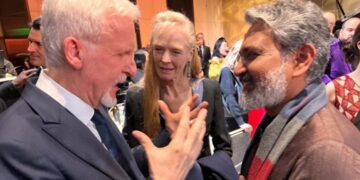Shillong: A first-of-its-kind ‘Aquatic Waste-to-Art Sculpture’ was inaugurated on Friday (November 14) at Lake View Point, Umiam — transforming nearly a ton of lake waste into a powerful symbol of environmental responsibility.
The initiative, led by the Smart Village Movement (SVM) under the guidance of the District Tourism Promotion Society (DTPS) in Ri Bhoi District, was executed in collaboration with the start-up Eco-Ri and local artist Joshua Lyngdoh.
The sculpture is crafted entirely from discarded materials collected from Umiam Lake, mostly worn-out footwear. The sculpture depicts a giant human foot crushing a half-submerged globe, encircled by fencing made of recycled plastic sheets. Beyond its striking design, the artwork delivers a vital message: humanity’s unchecked footprint is suffocating the planet, and the time to act is now.
Delivering the keynote address, Tourism Minister Timothy D. Shira highlighted the significance of the sculpture as a symbol of responsible tourism and community-driven sustainability.
He said, “This initiative beautifully reflects the spirit of responsible tourism we are promoting across Meghalaya. I congratulate the Smart Village Movement team, the District Tourism Promotion Society of Ri Bhoi, EcoRi, the local artist, and the Deputy Commissioner for bringing this creative idea to life through collective effort. This sculpture shows what becomes possible when innovation, environmental awareness, and community participation come together.”
He added, “Initiatives like this strengthen Meghalaya’s identity as a clean, green, and responsible tourist destination. I am also pleased to share that during a recent national conference, Umiam was proposed as one of India’s upcoming world-class tourist destinations. This recognition will greatly benefit the people of Meghalaya, especially communities living in and around Umiam.”
Laying emphasis on cleanliness and environmental protection, he urged the people of the region to continue maintaining and safeguarding the surroundings.
“With responsible practices and strong community support, Umiam Lake can truly become one of the most cherished destinations in our state. This sculpture stands as a powerful reminder of our shared duty to protect our natural treasures. Together, let us build a future where tourism uplifts our people, preserves our environment, and celebrates the beauty of our land,” he said.
Abhilash Baranwal, Deputy Commissioner of Ri Bhoi District, commended the initiative. He said, “By using waste collected directly from Umiam Lake, SVM has demonstrated how creativity and environmental responsibility can come together to promote truly responsible tourism. Umiam is one of our most cherished destinations, and preserving it is both an ecological duty and an economic necessity.”
He added that innovative products made from recovered plastic can already be seen at the site, reinforcing the idea that plastic should not always be treated as mere waste. “If we build the right ecosystem, we can incentivize people to manage plastic responsibly, benefitting both individuals and the wider community,” he said.
He further commented that the artwork stands as a reminder of what collective actions, good or bad, can create. “It encourages communities and visitors to treat waste responsibly and to recognise that even discarded materials can be transformed into something meaningful. I once again congratulate the SVM team, especially Pynshai and everyone involved, for turning this vision into reality. It is truly beautiful, and we look forward to collaborating on more such initiatives in the future.”
Speaking at the inauguration, Brenda L. Pakyntein, MCS, Director of Tourism, Meghalaya, said, “Seeing this Aquatic Waste-to-Art installation has been truly encouraging. It shows how sustainability and responsible tourism are taking root at Umiam Lake, one of our most sensitive and important tourist destinations.”
She added, “Tourism offers great livelihood opportunities, but it must grow without harming our environment. This initiative is a strong example of how creativity, community effort, and conservation can work together. The Tourism Department will continue supporting such projects through schemes like DTPS and the new Community-Led Tourism programme, and we encourage communities to make full use of these opportunities.”
Reflecting on the project, Pynshaiborlang Marpna, Project Lead – Infrastructure and Sustainability, Smart Village Movement, noted: “Every piece of waste we throw into the environment finds its way back to us. If we keep suffocating the earth with waste, we are suffocating our own children and future generations. Let us act with conscience before our carelessness becomes their burden.”
Bankit Nongbri, Founder of Eco-Ri, added: “This partnership allowed us, as a start-up from Meghalaya, to prove that innovation does not rely on perfect conditions. The artwork carries the journey of reclaimed waste from Umiam Lake, transformed into an installation that reflects creativity, accountability, and a new way of seeing waste.”
Joshua Lyngdoh, the artist behind the sculpture, said, “As an artist, I am passionate about repurposing scrap and non-biodegradable materials into meaningful art. Working with the Smart Village Movement has given me the opportunity to showcase what can be created when waste is transformed with creativity and purpose.”
He added, “This installation, built from hundreds of pieces of aquatic waste collected from Umiam Lake, is a reflection of that vision. While I may not be able to clean all the waste around us, I hope to contribute in my own way to inspire better waste management and show how discarded materials can take on new life through art.”
This project marks the first sculpture in Meghalaya constructed entirely from lake waste, demonstrating how environmental challenges can inspire creativity, innovation, and livelihood opportunities.















